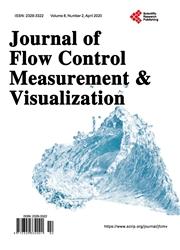FLOW LEAKS RENORMALIZATION
引用次数: 0
Abstract
Flow leaks are small devices that generate a well-determined flow when subject to a pressure differential (feed pressure). Such devices are widely used in the industry for the easy generation of flows, which can be used for several applications. In order to be correctly included in a Quality Management System (QMS), they need to be calibrated against a reference flow. Such calibration depends on the feed pressure and on the fluid density through a complex relation which can be derived from the modified Darcy law, therefore results of a calibration performed in a given condition are not necessarily valid when the leak is used in different conditions (e.g. different atmospheric pressure, ambient temperature). In the present paper we will show how to obtain a correct renormalization of the calibration results, which, if applied in use, allows to compute precisely the actual flow rate generated by the leak. The renormalization is based on the modified Darcy law, and therefore requires the determination of the leak permeability. A mathematical description of the renormalization will be presented. Additionally, a method for the experimental determination of the permeability will be discussed The effect of the renormalization on the output of the leak will be demonstrated through a set of example cases, obtained in various environmental conditions within our laboratory. It will be shown that, first the calibration uncertainty can be reduced dramatically by applying the correct normalization, and second that the in-use uncertainty can be brought to be of the same order of magnitude as the calibration uncertainty.流量泄漏重整
流动泄漏是一种小型装置,当受到压力差(进料压力)的影响时,会产生确定的流量。这种装置在工业中广泛使用,因为它易于产生流量,可用于多种应用。为了正确地包含在质量管理体系(QMS)中,它们需要根据参考流程进行校准。这种校准取决于进料压力和流体密度,这是一种复杂的关系,可以从修正的达西定律中推导出来,因此,在给定条件下进行的校准结果不一定有效,当泄漏在不同的条件下使用时(例如,不同的大气压力,环境温度)。在本文中,我们将展示如何获得校准结果的正确重整化,如果在使用中应用,可以精确地计算泄漏产生的实际流量。重整是基于修正的达西定律,因此需要确定泄漏渗透率。重整化的数学描述将被提出。此外,还将讨论一种测定渗透率的实验方法。重整化对泄漏输出的影响将通过我们实验室在各种环境条件下获得的一组实例进行演示。结果表明,首先,采用正确的归一化方法可以大大降低校准不确定度;其次,可以使使用中的不确定度与校准不确定度具有相同的数量级。
本文章由计算机程序翻译,如有差异,请以英文原文为准。
求助全文
约1分钟内获得全文
求助全文

 求助内容:
求助内容: 应助结果提醒方式:
应助结果提醒方式:


